Florida
state of the United States of America
Florida is the southernmost state in the continental United States of America. Known as "The Sunshine State", over a century ago it became a popular winter destination for the well-to-do from colder climates; it has grown to become the second-most visited state in the nation. Tourists have long been drawn to Florida by its white-sand beaches and unique and diverse cities. Since the mid-twentieth century, world-class theme parks and attractions have become a top draw as well. In the 21st century, Florida has become the preferred retirement destination for rich Americans from all over the country.
- For other places with the same name, see Florida (disambiguation).
The state's roots in agriculture are still relevant, with oranges being a chief export. Untouched natural landscapes teeming with wildlife exist in vast areas, sometimes very close to cities, and there are miles of rivers and trails for the intrepid visitor. Some of Florida's best secrets are charming small towns and other places in secluded locations, away from the crowded tourist areas but certainly worth seeing.
Regions
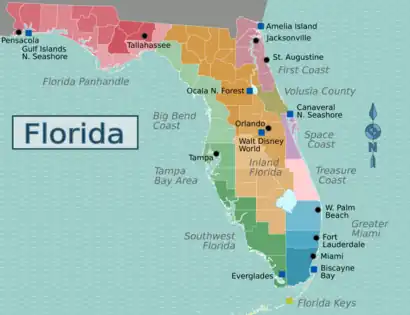
| First Coast The end of the St. Johns River is the location of Jacksonville, one of the largest cities in the state, and some coastal towns including America's oldest city, St. Augustine. |
| Volusia County A beach county, also known as the "Fun Coast," frequented by snowbirds, Inland Florida residents, and fans of the Daytona 500. |
| Space Coast The Kennedy Space Center, Cape Canaveral, and some coastal towns to the south are within this region, which is synonymous with Brevard County. |
| Treasure Coast Between Miami and the rest of the Atlantic coast, there are some medium-sized cities here, but it is still more off the beaten path than the counties to the south. |
| Greater Miami (Palm Beach County, Broward County, Miami-Dade County) Miami and its surroundings (called the "Gold Coast") are known for their ethnic diversity, proximity to Latin America, and tourist appeal along the many miles of beautiful beaches. |
| Florida Keys A chain of islands off the southern tip of the peninsula, and one of the state's main tourist destinations with its breathtaking tropical beauty. |
| Florida West Coast (Big Bend Coast, Tampa Bay Area, Southwest Florida) Particularly in the north, more rural than its eastern counterpart, the western coast is known for its Tampa-St. Petersburg metro area and many beautiful beaches in the southwest of the state, with the Everglades separating the region from Miami. |
| Florida Panhandle (Emerald Coast, Forgotten Coast, Middle Florida, West Florida) The Florida panhandle is a "Deep South" region of antebellum plantations, red hills, and white sand beaches. Cities include the state capital of Tallahassee, Destin, Pensacola, and Panama City Beach. |
| Inland Florida (North Central Florida, Greater Orlando, Lake County, Polk County, Florida Heartland) A few cities dot this mostly rural region, including the college town of Gainesville, the theme parks of Orlando, and small towns throughout the rest. |
Cities
Below is a selection of some of Florida's most notable cities. Other cities can be found under their specific regions.
- 🌍 Tallahassee – The state capital and thriving college town home to three schools, including Florida State
- 🌍 Fort Lauderdale – The "Venice of America" with its expansive canal system, also known for beaches and boating
- 🌍 Jacksonville – Sprawling city encompassing large beaches, world-class museums, and award-winning golf
- 🌍 Miami – The center of Caribbean and Latin American culture, famed for its beachfront nightclubs
- 🌍 Orlando – The theme park capital of the world also features exciting dining, a lively arts scene, and ample recreation
- 🌍 Pensacola – White-sand beaches draw tourists to this town of ancient shipwrecks and military fighter jets
- 🌍 St. Augustine – The oldest city in the country is home to two more-than 400-year-old Spanish forts, restaurants, and shops
- 🌍 Tampa – Large Gulf Coast metro area home to bustling nightlife as well as famed natural sites
- 🌍 West Palm Beach – Ritzy town home to the rich & famous, featuring high-end shopping and beautiful beaches
Other destinations
.jpg.webp)
- 🌍 Amelia Island – Historic island at the north end of the state, with excellent golf resorts and a lively downtown
- 🌍 Biscayne National Park – A massive marine park protecting a wide range of animals and coral reefs
- 🌍 Canaveral National Seashore – The longest stretch of unspoiled beach on the Atlantic coast, near rocket launches
- 🌍 Everglades National Park – Massive, vital, and delicate ecosystem protecting a great variety of plants and animals
- 🌍 Florida Keys – Chain of islands stretching into the Caribbean, offering tropical scenery and a laid-back lifestyle
- 🌍 Gulf Islands National Seashore – 12 islands along the Gulf Coast, featuring excellent beaches and sea turtles
- 🌍 Ocala National Forest – Extensive inland forest giving visitors a taste of old Florida charm
- 🌍 Walt Disney World – The "happiest place on earth", encompassing 4 theme parks, 2 water parks, and countless other amenities
Understand
While Florida is considered to be part of the South, it originated not as a British colony, but as a Spanish one. As a result, the state has a unique history. Although Florida was a founding member of the Confederate States of America, and like other Southern states shared the experience of slavery and racial segregation during its history, today, Florida is a very diverse state. It is almost evenly divided between Republicans and Democrats, and contains a number of regions with slight cultural differences of their own that contribute to the state's diversity. Therefore, no one accent dominates in the speech of its residents, and it's often said that Florida is the only state that gets more "Southern" the farther north you go, and that is indeed true in a cultural sense.
History
Florida was inhabited by Native Americans for over 13,000 years before the arrival of European explorers, colonists and slavers. It is estimated that there were some 350,000 inhabitants, of many tribes, when the Spanish explorer Juan Ponce de León arrived in 1513 in search of, according to legend, the Fountain of Youth.
The first European settlement dates back to the 1560s with St. Augustine, established in 1565, holding the distinction of being the oldest permanent European settlement in what is now the United States. However, this early settlement did not lead to the same level of rapid colonization that took place in the British colonies to the north, as the climate made large-scale settlement, especially inland, difficult for Europeans who were used to milder climates. Attempted settlements by Europeans, such as the New Smyrna Beach colony owned by a British man who employed former inhabitants of the Balearic Islands, were not always successful as challenges of climate and disease took their toll on the residents, who themselves ultimately moved to St. Augustine. From this time onward the state would not see large-scale economic and population expansion until Florida's statehood in the 19th century, when agriculture — including notably orange trees — and later tourism would achieve important roles in the state's economy.
Along with the climate challenges, battles and competing claims for the region posed a challenge to the region's settlers. However, many Africans and African-Americans moved to Florida during the territory's early years because King Charles of Spain had issued a royal proclamation freeing all slaves who fled to Spanish Florida, if they converted to Catholicism.
|
Shooting for the Stars
A source of pride and joy in Florida is its outsize role in the history of space exploration. Cape Canaveral began to be used for missile launches in 1949, and following President John F. Kennedy's vow to put American astronauts on the Moon before the end of the 1960s, early space flights took place there on converted missiles. The most important launches by NASA, including the Apollo 11 moon launch watched around the world in 1969, have taken place at the John F. Kennedy Space Center in Cape Canaveral. Unfortunately, however, to make way for the creation of the space center, many residents of the Cape Canaveral region, including some African-Americans, were required by the government to leave Cape Canaveral, and little remains of the settlements that once existed in the Cape Canaveral region. |
Native Americans, including members of the Calusa tribe, fought effectively to defend their tribal lands from European colonization of the region; therefore it was some time before Europeans established colonies. However, once Europeans took control of the Florida region, oppression and killing of Native Americans — often as a result of war or disease — was tragic as it was in many other regions of the Americas. Following substantial depopulation of the state's native tribes, the Seminole tribe moved in and established themselves in Florida in the 18th century, though several conflicts between the Spanish, attempting to maintain Florida, and Americans attempting to annex the region, made an already disputed territory's political situation complex for Native Americans and settlers. Native Americans living in Florida fought hard and continued to guard their independence after Spanish Florida was ceded to the United States in 1821.
The new territory of the U.S. was a slave plantation economy, much like the rest of the South at the time; the Seminoles gladly welcomed runaway slaves and accepted them into their tribe. However, after the Second Seminole War, almost the entire tribe was deported west of the Mississippi River as part of the Trail of Tears.
Florida was admitted to the Union as a slave state in 1845, but seceded and joined the Confederacy with the rest of the South in 1861. Largely untouched by the American Civil War, the state enforced Jim Crow segregation laws against its then very large (approximately 44%) black population for a century after the Confederates' defeat. By the early 20th century, Florida had more lynchings per capita than any other state.
However, there were three 20th-century migrations that fundamentally changed the character of Florida, to the extent that many people no longer consider much of the state to be culturally Southern: the move of one-fifth of the state's African-American population to the Northern United States as part of the Great Migration during the first decades of the 20th century; the arrival of an increasing number of white retirees from the North after the spread of air conditioning in the 1950s; and the arrival of several waves of Cuban immigrants after the victory of Fidel Castro in 1959, who established themselves primarily in South Florida, particularly Dade County. Florida has also seen major influxes of Latino immigrants from Puerto Rico, the Dominican Republic, Central and South America, and Mexico, and there have also been many Haitian immigrants.
Culture
.jpg.webp)
Florida is geographically the southernmost of the contiguous United States, and it is a unique blend of societies. The Florida Panhandle, much of North Florida, rural areas of Central Florida, and the Florida Heartland remain part of the cultural region of the South, where you will find traditional southern cooking, entertainment, dialect, and lifestyles, much as you would expect in states like Georgia or Alabama. Generally, the further south you go in the state, the more unlike the South it seems, and although Southern culture can be found in every region of the state, it is not always prevalent.
Cities such as Tampa and Orlando offer the feel of the South, alongside many other cultures. There are a lot of Southerners in these areas, but also many people who are from other areas like the Midwest or the Northeast. Miami, on the other hand, is unique in that it feels like a cross between an American metropolis and a major Latin American city (like Rio or São Paulo). There are some Seminole Native American reservations and villages throughout southern Florida, namely in the Everglades, and their indigenous culture can be experienced by visiting a shop and browsing arts and crafts. The southernmost Florida Keys offer yet another flavor, full of the casual, slow-paced atmosphere of beach life. In short, Florida is a full-fledged region of the United States in its own right.

Much of the southern part of Florida is inhabited by people of Hispanic or Latino origin. The region that is substantially to in places majority Hispanic or Latino extends north to Orlando. There are large Cuban and Puerto Rican populations in Miami and the south side of Greater Orlando, respectively. The white population is higher to the north, and by the northern border with Georgia and Alabama, the Hispanic/Latino population is very low. The Black or African-American population is primarily on the mainland and throughout the state, with historically Black communities and history in the Daytona Beach metro area, Jacksonville, and Gadsden County in the Panhandle. The ethnic diversity of Florida, while not particularly cosmopolitan outside of certain urban centers, has contributed substantially to the culture, with Spanish spoken in some areas, but in the north, a tendency toward American cuisine and English language exists with few alternatives and much of the population of this region are known by outsiders as "rednecks." There are smaller communities of ethnic minorities including those of Anglo- or Franco-Caribbean or Middle Eastern origin, but these have a smaller impact on the state's culture than the largest ethnic groups.
Due to a combination of factors, despite the state's high urbanization relative to many other Southern states, it does not lean as "liberal" as many comparably urban and ethnically diverse states in the North. The state is considered to be on the tipping point between left and right, but despite the prominently right-wing government that scraped through the 2018 elections, the state as a whole is middle of the road for the U.S. Orlando, state capital Tallahassee, Fort Lauderdale and college town Gainesville lean left while most of Miami, Tampa-St Petersburg, southwest Florida, parts of the east coast and rural inland and Panhandle lean conservative when compared with demographically similar communities in other parts of the country. However, almost all regions of the state are politically diverse.
Landscape
Florida's coastline is world class, with several gorgeous beaches, bays, and estuaries. The Floridian landscape is extremely flat, however, with lakes and wetlands scattered throughout most of the state, though a mixture of ecosystems distract from the lack of topography. The only exceptions are parts of Highlands, Polk, Lake, and a few other counties in the center of the state where rolling hills are common. The highest point in the state is the 345 ft (105 m) Britton Hill on the Panhandle, and the 298 ft (91 m) Iron Mountain in Polk County is the highest point on the Peninsula.
Florida's cities tend to be big, sprawling, and well-developed, but not as close to each other as an atlas might imply. Despite being a densely-populated state, there are fortunately still several expanses of wilderness left, although these are often near or between populated urban areas.
Some rural parts of the state grow citrus and sugar cane, but farmland tends to be in regions outside the usual tourist areas. The Florida Panhandle and most of North Florida consist of farmland and pine trees, but as you travel south, you'll see more wetlands and urbanization, culminating at the Everglades in the far south of the state near Miami. The Florida Keys are a small chain of tropical islands with their own unique geography.
Climate
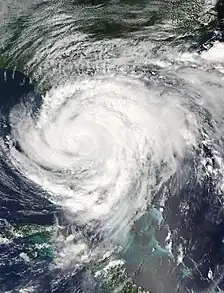
Florida is known around the world for warm and sunny weather and this has led to the state being a major tourist destination. Florida has the mildest winters on the US mainland, and retirees and temporary residents known as "snowbirds", flock to the state in the cold season. Coastal areas experience gentle breezes during the summer, and the beach is usually the coolest place to be.
While those coastal breezes are a welcome relief from the scorching temperatures, they are also the cause of a well-known Florida weather feature: thunderstorms. While the storms are often brief, they are common, and anyone visiting Florida during the rainy season (mid-June to September) should plan a few indoor activities in the afternoons as a backup. Florida's thunderstorms occur every day during the rainy season and typically form 20-30mi (32-48km) inland and either move toward the center of the state or toward the coast. Due to this, rain can be occurring just a few miles inland from the coast, while those at the beach experience a beautiful day.
While the storms cool the air, bringing a welcome though often short relief to stifling temperatures, many produce considerable amounts of dangerous lightning and some bring hail, high winds of 50 mph (80 km/h) or more, and tornadoes. See the "stay safe" section for thunderstorm safety. Many tourist areas, such as Walt Disney World, have multiple attractions available even during downpours.
The spring is the driest time of the year, leading to wildfires nearly every May and early June.
The six-month hurricane season runs from June 1 through November 30 and Floridians have learned to be ready when a storm threatens the area. If you plan on visiting during the months of June through November and especially during the peak of the hurricane season from August through October, stay aware of the news and weather advisories. Information is available from the National Hurricane Center. Cyclones are unlikely but possible in the month of May.
From June through October is the hot and wet season in Florida. High temperatures are often in the 80s to 90s F and lows in the 70s. The Bermuda High pumps in hot and unstable tropical air from the Bahamas and Gulf of Mexico, which help create the daily thundershowers that are typical in summer months in Florida. Intense but very brief downpours are common in summer in much of Florida. Normally, the wet season starts to fade by early November in northern Florida and reaches southern Florida by late November.
From December through April the weather in much is Florida is mild and often dry. The dry season (or winter) is often the driest and most sunny season in Florida, Average high temperatures range from the low 60's in northern Florida to the mid 70's F in far southern Florida. Overnight lows fall to the middle 40's in northern Florida to near 60 F in far southern Florida. A few times each winter, a strong cold front may drop temperatures to near freezing across northern Florida, though in many years there is no freeze at all from central Florida southward. In the driest months, Florida often has long periods of rainless weather, and by April drought conditions with brush fires and water restrictions in place are sometimes.
Tourist information
- Visit Florida website
Talk
English is the official language of the state. However, Spanish is the native language of approximately 20% of Florida residents, and the further south you go, the more Spanish speakers there will be. In some parts of South Florida, Spanish is the preferred language in everyday activities. Miami is most notable, where nearly 80% of residents do not speak English as their native language and 30% do not speak any English at all. Tampa also has a sizable Spanish-speaking population, and neighborhoods where it is almost exclusively spoken. Like anywhere where there is a large presence of another language, expect Spanish words or expressions used or calqued into everyday English.
Gullah, a distinctive English-based creole, is spoken by some African-American communities along the northeastern coast, near the border with Georgia.
Native-born non-Hispanic Floridians from the northern part of the state will usually speak with a Southern accent. However, after the migration of millions of Americans from all over the country to the central and southern parts of the state, the Southern dialect is becoming diluted with other accents. Residents of Miami often speak in a distinctive accent with strong influences from Cuban Spanish.
Get in
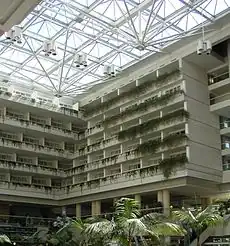
By plane
- See also: Air travel in the United States
- 🌍 Orlando International Airport (MCO) - your choice airport for Disney World and the other attractions in Central Florida. Located south of downtown Orlando, this airport offers tons of car rentals and free shuttles to Disney and Universal for visitors. Being centrally located it serves as a hub or focus city for Jetblue, Frontier, Southwest and Spirit Airlines. There are international connections from South America, Caribbean, Central America, Mexico, Europe and the middle east.
- 🌍 Miami International Airport (MIA) - the biggest airport for travel in South Florida, it's the best option for trips to the Everglades or Miami's beaches. The airport is a hub for American Airlines and the most popular entry point with a wide variety of flights from Europe, South America, Central America, the Caribbean, Cuba and Mexico.
- 🌍 Tampa International Airport (TPA) - serves the Gulf Coast, namely the Tampa Bay area. There are direct flights offered from all over the U.S. and from a number of international destinations in Canada, Cuba, Europe, Latin America and the Caribbean.
- 🌍 Fort Lauderdale-Hollywood International Airport (FLL) - the fourth-largest airport in Florida, and another valid option to consider with many domestic low-fare carriers such as Allegiant, JetBlue, Frontier Airlines, Spirit Airlines and Southwest Airlines.
- 🌍 Jacksonville International Airport (JAX) - primary airport for travel in North Florida, serving Amelia Island and historic St. Augustine.
Other large airports can be found in Pensacola, Fort Myers, Tallahassee, Saint Petersburg/Clearwater, West Palm Beach, Sarasota, Key West, Gainesville, Melbourne, and Sanford. There are many more airports throughout Florida that may get you closer to your destination; watch for these smaller airports while researching your destination.
By car
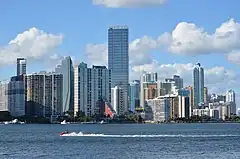
Three Interstate highways connect Florida with adjacent states:
 Interstate 10 (I-10) enters Florida from Alabama near Pensacola and passes through the center of the Panhandle and across North Florida until its terminus in Jacksonville. Interstate 10 is most convenient for travelers from Louisiana, Texas, and areas farther west.
Interstate 10 (I-10) enters Florida from Alabama near Pensacola and passes through the center of the Panhandle and across North Florida until its terminus in Jacksonville. Interstate 10 is most convenient for travelers from Louisiana, Texas, and areas farther west. I-75 also enters Florida from Georgia and passes through the center of the state until the Tampa Bay area, after which it follows the Gulf of Mexico coast (10-20 mi/16-32 km inland) to Naples, where it heads due east across the Everglades to Fort Lauderdale. Interstate 75 is most convenient for travelers arriving from Atlanta and the Midwest.
I-75 also enters Florida from Georgia and passes through the center of the state until the Tampa Bay area, after which it follows the Gulf of Mexico coast (10-20 mi/16-32 km inland) to Naples, where it heads due east across the Everglades to Fort Lauderdale. Interstate 75 is most convenient for travelers arriving from Atlanta and the Midwest. I-95 enters Florida from Georgia just north of Jacksonville and parallels the Atlantic coast, never more than 25 miles inland, until its terminus south of downtown Miami. Interstate 95 provides the most convenient route for people from the East Coast, New England, eastern parts of Canada. Jacksonville, Daytona Beach, and the Miami-Fort Lauderdale-West Palm Beach area are all serviced by I-95, with access to Orlando provided via Interstate 4.
I-95 enters Florida from Georgia just north of Jacksonville and parallels the Atlantic coast, never more than 25 miles inland, until its terminus south of downtown Miami. Interstate 95 provides the most convenient route for people from the East Coast, New England, eastern parts of Canada. Jacksonville, Daytona Beach, and the Miami-Fort Lauderdale-West Palm Beach area are all serviced by I-95, with access to Orlando provided via Interstate 4.
 I-4 does not cross any state line but is still called an interstate. It crosses the state from Gulf to East coast, passing from Tampa in the west through Orlando and ending at the western boundary of Daytona Beach. It curves to the north on its easternmost segment. The road, particularly on the north side of Orlando, is notoriously dangerous, and the frequent thunderstorms in addition to ongoing road work don't help with this concern. The speeds on this road are high and speed limits are ignored by most, but as a quick route there are few comparable alternatives and it does a good job of connecting the suburbs.
I-4 does not cross any state line but is still called an interstate. It crosses the state from Gulf to East coast, passing from Tampa in the west through Orlando and ending at the western boundary of Daytona Beach. It curves to the north on its easternmost segment. The road, particularly on the north side of Orlando, is notoriously dangerous, and the frequent thunderstorms in addition to ongoing road work don't help with this concern. The speeds on this road are high and speed limits are ignored by most, but as a quick route there are few comparable alternatives and it does a good job of connecting the suburbs.
Additional major highways entering Florida include:
 US-1 enters Florida north of Jacksonville and snakes along the east coast between Interstate 95 and the Intracoastal Waterway/Atlantic Ocean. Unlike I-95, US 1 continues past Miami and is routed over a series of bridges (including the famous Seven Mile Bridge) through the Florida Keys to its terminus at Key West.
US-1 enters Florida north of Jacksonville and snakes along the east coast between Interstate 95 and the Intracoastal Waterway/Atlantic Ocean. Unlike I-95, US 1 continues past Miami and is routed over a series of bridges (including the famous Seven Mile Bridge) through the Florida Keys to its terminus at Key West. US-27 enters Florida from western Georgia and provides access to the state capital, Tallahassee, before routing through mostly rural areas of the peninsula. Down the center of the state between Florida's Turnpike and Miami, US 27 is a primary trucking route, and as such this route can be a hassle while dealing with heavy traffic.
US-27 enters Florida from western Georgia and provides access to the state capital, Tallahassee, before routing through mostly rural areas of the peninsula. Down the center of the state between Florida's Turnpike and Miami, US 27 is a primary trucking route, and as such this route can be a hassle while dealing with heavy traffic. US-98 enters Florida near Pensacola and remains close to the Gulf of Mexico coast until the Panhandle meets the Florida peninsula at the "Big Bend" area. Unlike I-10 to the north, which runs through the interior of the Panhandle away from the coast, US 98 provides a scenic drive and convenient access to the beaches. After leaving the Panhandle, US 98 runs diagonally down the peninsula to West Palm Beach through primarily rural areas.
US-98 enters Florida near Pensacola and remains close to the Gulf of Mexico coast until the Panhandle meets the Florida peninsula at the "Big Bend" area. Unlike I-10 to the north, which runs through the interior of the Panhandle away from the coast, US 98 provides a scenic drive and convenient access to the beaches. After leaving the Panhandle, US 98 runs diagonally down the peninsula to West Palm Beach through primarily rural areas. US-231 enters Florida from Alabama and crosses the Panhandle north-south to its southern terminus at Panama City Beach. US 231 provides convenient access to the Panhandle from the Midwest via it connection with Interstate 65 in Montgomery.
US-231 enters Florida from Alabama and crosses the Panhandle north-south to its southern terminus at Panama City Beach. US 231 provides convenient access to the Panhandle from the Midwest via it connection with Interstate 65 in Montgomery. I-301 enters Florida just north of Jacksonville and was once the main route from the Northeast. It is a very scenic alternative to I-95 with a lot less traffic. Exiting I-95 at Santee, South Carolina motorists can follow US 301 through Georgia and into Florida and connect to I-95 again in Jacksonville for Atlantic coast destinations, or continue on to join I-75 at Ocala for Tampa and the Gulf coast.
I-301 enters Florida just north of Jacksonville and was once the main route from the Northeast. It is a very scenic alternative to I-95 with a lot less traffic. Exiting I-95 at Santee, South Carolina motorists can follow US 301 through Georgia and into Florida and connect to I-95 again in Jacksonville for Atlantic coast destinations, or continue on to join I-75 at Ocala for Tampa and the Gulf coast.
By bus
Many bus companies operate services to Florida from neighboring states and from the major airports in the states. Service is most frequent along the interstates from large cities in neighboring states. See By bus under Get around for a list of bus companies serving the state.
By train
Amtrak has two services to Florida:
- Amtrak Auto Train (Trains #52 & 53) carries passengers and automobiles between Lorton, Virginia and Sanford, Florida (north of Orlando), effectively serving as a car-rail link to Florida from the Washington, D.C. metro area. This train makes no stops between Lorton & Sanford and is a way to cut back on the extra mileage and wear and tear on the car.
- Amtrak Silver Service (Trains #91 & 92 and #97 & 98 respectively) are two routes that both begin in New York City and end in Miami. The trains follow the same route heading to Florida, except in North and South Carolina. Within the state, the trains run the same line from Jacksonville to Kissimmee. There, they split again, and the Silver Star (Trains #91 & 92) diverges to head west towards Lakeland and Tampa while the Silver Meteor (Trains #97 & 98) continues south towards Winter Haven. Both routes meet again further south and serve the rest of the stations along Florida's east coast to Miami.
By boat
Florida is possibly the largest state for cruise ship vacations in the United States. Cape Canaveral, Tampa, Miami, and Fort Lauderdale are all popular starting ports, with cruises heading throughout the Caribbean. There are also many short-term casino cruises that depart from Pinellas County and around South Florida.
Ferry service is also available to and from the Bahamas, with service between Fort Lauderdale and Freeport, and between Miami and Bimini.
Get around
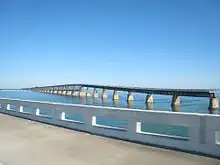
By car
Traveling by car is the most common and most convenient way to get around the state for travelers and locals alike. For the traveler car rental agencies are abound in Florida and many are available at every major airport. Orlando, in particular, is known as the "Car Rental Capital of the World". With Florida being the most visited state in the US, car rental rates here are among (if not the) lowest rates in the country due to sheer volume.
Florida's major highways include:
 Interstate 4 (I-4) crosses diagonally from Tampa, heads east through Plant City and Lakeland, then continues northeast past Kissimmee, Walt Disney World, and Orlando, before ending at Interstate 95 near Daytona Beach. Interstate 4 is the most travelled highway in Florida and due to the large volume of traffic, high speeds (70 mph,112 km/h outside of urban areas), construction, and large number of tourists it is also the most dangerous highway in the state, in terms of the number of accidents.
Interstate 4 (I-4) crosses diagonally from Tampa, heads east through Plant City and Lakeland, then continues northeast past Kissimmee, Walt Disney World, and Orlando, before ending at Interstate 95 near Daytona Beach. Interstate 4 is the most travelled highway in Florida and due to the large volume of traffic, high speeds (70 mph,112 km/h outside of urban areas), construction, and large number of tourists it is also the most dangerous highway in the state, in terms of the number of accidents. &
&  I-10 and US-90 enter Florida from Alabama near Pensacola and travels across the Panhandle, past Tallahassee and Lake City, and through rural North Florida to its terminus at I-95 in Jacksonville. US Hwy 90 straddles I-10 through the northern Florida Panhandle, going through the cities and towns as a local surface street/highway while I-10 goes straight through bypassing the cities and towns. US Hwy 90 continues past the I-95 corridor in downtown Jacksonsville and ends at FL A1A at Jacksonville Beach.
I-10 and US-90 enter Florida from Alabama near Pensacola and travels across the Panhandle, past Tallahassee and Lake City, and through rural North Florida to its terminus at I-95 in Jacksonville. US Hwy 90 straddles I-10 through the northern Florida Panhandle, going through the cities and towns as a local surface street/highway while I-10 goes straight through bypassing the cities and towns. US Hwy 90 continues past the I-95 corridor in downtown Jacksonsville and ends at FL A1A at Jacksonville Beach. I-75 enters Florida from Georgia and runs south through the center of the peninsula past Gainesville and Ocala before crossing just east of Tampa, where it then parallels the Gulf coast past Bradenton, Sarasota, Fort Myers, and Naples, after which it travels due east across the Everglades (a section known as 'Alligator Alley') to the Miami suburbs.
I-75 enters Florida from Georgia and runs south through the center of the peninsula past Gainesville and Ocala before crossing just east of Tampa, where it then parallels the Gulf coast past Bradenton, Sarasota, Fort Myers, and Naples, after which it travels due east across the Everglades (a section known as 'Alligator Alley') to the Miami suburbs. I-95 enters Florida from Georgia, north of Jacksonville, and travels down the Atlantic coast past St. Augustine, Daytona Beach, Cape Canaveral, Vero Beach, West Palm Beach, and Fort Lauderdale before ending at US 1 just south of downtown Miami.
I-95 enters Florida from Georgia, north of Jacksonville, and travels down the Atlantic coast past St. Augustine, Daytona Beach, Cape Canaveral, Vero Beach, West Palm Beach, and Fort Lauderdale before ending at US 1 just south of downtown Miami. The Florida Turnpike is a toll road that runs from I-75 south of Ocala, through Orlando, West Palm Beach, and Fort Lauderdale before ending south of Miami. It provides the easiest access to Orlando and southeast Florida for persons entering the state via I-75 or I-10.
The Florida Turnpike is a toll road that runs from I-75 south of Ocala, through Orlando, West Palm Beach, and Fort Lauderdale before ending south of Miami. It provides the easiest access to Orlando and southeast Florida for persons entering the state via I-75 or I-10. I-275 is a secondary Interstate that runs from I-75 north of the Tampa area, past downtown Tampa and Saint Petersburg, where it crosses the 5.5-mile-long (8.8km), 193 foot-tall (58.8m) Sunshine Skyway Bridge before it rejoins I-75 south of Bradenton. Interstate 75 does not provide access to these areas, it instead passes through rural and suburban areas 10 miles east of Tampa.
I-275 is a secondary Interstate that runs from I-75 north of the Tampa area, past downtown Tampa and Saint Petersburg, where it crosses the 5.5-mile-long (8.8km), 193 foot-tall (58.8m) Sunshine Skyway Bridge before it rejoins I-75 south of Bradenton. Interstate 75 does not provide access to these areas, it instead passes through rural and suburban areas 10 miles east of Tampa. US-1 is a historic and scenic highway that travels down the Atlantic coast between I-95 and the ocean before being routed over a series of bridges (including the famous Seven Mile Bridge) through the Florida Keys to its terminus at Key West.
US-1 is a historic and scenic highway that travels down the Atlantic coast between I-95 and the ocean before being routed over a series of bridges (including the famous Seven Mile Bridge) through the Florida Keys to its terminus at Key West. FL-A1A runs parallel to US Hwy 1 as the coastal highway along the east coast. It serves the beach communities as a local street (such as Collins Ave in Miami Beach or Ocean Dr in Ft Lauderdale) in the offshore islands/keys along the entire east coast. It is fragmented and does not run continuously from South Beach to Fernadina Beach. It runs concurrent on US Hwy 1 in places where it is not a separate road.
FL-A1A runs parallel to US Hwy 1 as the coastal highway along the east coast. It serves the beach communities as a local street (such as Collins Ave in Miami Beach or Ocean Dr in Ft Lauderdale) in the offshore islands/keys along the entire east coast. It is fragmented and does not run continuously from South Beach to Fernadina Beach. It runs concurrent on US Hwy 1 in places where it is not a separate road. US 27 is a well-traveled alternative to Florida's Turnpike and runs from Miami, along Lake Okeechobee and through the mostly-rural Heartland of Florida before continuing through Ocala, Gainesville, and Tallahassee.
US 27 is a well-traveled alternative to Florida's Turnpike and runs from Miami, along Lake Okeechobee and through the mostly-rural Heartland of Florida before continuing through Ocala, Gainesville, and Tallahassee. US 41 runs west from Miami on a scenic 2-lane journey through the Everglades, and then travels along the Gulf Coast, around the east side of Tampa Bay, and north into Georgia.
US 41 runs west from Miami on a scenic 2-lane journey through the Everglades, and then travels along the Gulf Coast, around the east side of Tampa Bay, and north into Georgia. US 98 enters Florida from Alabama at Pensacola and travels a very scenic route along the Gulf Coast of the Panhandle, after which it continues diagonally across the peninsula to its terminus in West Palm Beach.
US 98 enters Florida from Alabama at Pensacola and travels a very scenic route along the Gulf Coast of the Panhandle, after which it continues diagonally across the peninsula to its terminus in West Palm Beach.
By plane
Flying may be a more reasonable option for crossing large expanses of the state especially between South Florida (Miami and Ft Lauderdale) and the Panhandle (Pensacola and Tallahassee) while others will be relatively short (Ft Lauderdale to Orlando). Silver Airways and Atlantic Airlines offer the most point to point intrastate connections between large and small airports in different route combinations. American Airlines/American Eagle operates intrastate flights from their base in Miami to Jacksonville, Key West, Orlando, Pensacola, Tallahassee and Tampa. To a lesser extent Frontier, JetBlue, Southwest and Spirit have flights from their base in Ft Lauderdale and Orlando to Ft Myers, Orlando, Pensacola, Tallahassee, and/or Tampa.
By bus
The bus is not the most glamorous way to get around the state, but it can be the cheapest. There is fairly frequent service from Orlando (as a 'de-facto' hub) to Naples (via Tampa Bay, Ft Myers); South Florida (W Palm Peach, Ft Lauderdale, Miami); Jacksonville (via Daytona Beach, Ft Pierce); and the Panhandle (via Gainesville, Ocala, Tallahassee) with multiple companies. Others offer connections to the Keys through Miami-Dade and north towards Jacksonville along I-95 without going through Orlando. Check schedules. Many of the smaller companies, county bus services, and those connecting rural towns are not listed, check the article of your destination and the schedules of the company for all the transportation options. Information on transit (local public transportation) can be found here:
- Greyhound Lines, toll-free: +1-800-231-2222. Connects South Florida (Miami and Ft Lauderdale) to Tampa, Naples and Jacksonville through Orlando with onward connections to Atlanta, Savannah, Houston and other cities north from Orlando. They also operate a less frequent service from Miami to Tampa via Belle Glade, Clewiston and Ft Myers. They also go south to Key West via the Florida Keys from Miami and north towards Jacksonville from Miami along I-95. Check schedules.
- Jet Set Express, ☏ +1 407 649-4994. Venue at stop open 24/7. Thrice Daily departures to Ft Pierce, Kissimmee, Orlando from the Miami. Check schedules for a listing of other stops which are serviced once or twice daily. (updated Jul 2019)
- Keys Shuttle, ☏ +1 305-289-9997, toll-free: +1-888-765-9997. The company provides door-to-door service to the Keys from the Miami and Ft. Lauderdale-Hollywood International Airports (and vice versa). (updated Sep 2017)
- Megabus. Connects South Florida (Miami and Ft Lauderdale) to Tampa, Naples and Jacksonville through Orlando with onward connections to Atlanta, Savannah and other cities.
- Omnibus la Cubana, ☏ +1 305-541-1700. Connects Miami to New York City through Florida, Georgia, South Carolina, North Carolina, Washington, DC; Elkton, Maryland; Philadelphia and New Jersey on a single route. In Florida they serve Miami, Ft Lauderdale, West Palm Beach, Deltona and Jacksonville. (updated Jun 2015)
- Our Bus (Operated by different bus companies on contract to Our Bus), Terminal B of the Port of Miami Cruise Terminal, ☏ +1 844 800-6828. Operates service between the Miami Cruise Terminals, Ft Lauderdale Airport, Tampa, Sarasota and Ft Myers. Fares range from $10 to $22 or more.
- Palm Lines. Connects Chicago to Miami through Jacksonville, St Augustine, Daytona Beach, Melbourne, Vero Beach and West Palm Beach along I-95 in Florida (updated Dec 2020)
- Redcoach, ☏ +1 407-851-2843, toll-free: +1-877-733-0724. Service from Tallahassee to Miami via Ocala, Gainesville and Ft Lauderdale. One branch go through Orlando through Ft Pierce, W Palm Beach and Pompano Beach. Another go through Tampa, Ft Myers and Naples. (updated Sep 2017)
There are a number of local and regional public transportation agencies that offer intercity bus services throughout the state. Information on transit can be found here.
By train
- Amtrak Silver Star (Trains #91 & 92) and Silver Meteor (Trains #97 & 98) - This is a relatively expensive option but will suffice if other means are not possible. Both routes span from Jacksonville to Miami. While the two routes are slightly different, they both stop at the following stations: Jacksonville, Palatka, DeLand, Winter Park, Orlando, Kissimmee, Winter Haven, Sebring, Okeechobee, West Palm Beach, Delray Beach, Deerfield Beach, Fort Lauderdale, Hollywood, and Miami. The slight difference between the two routes is that the Silver Star detours to Lakeland (to/from the north only) and Tampa (to/from the south only) while the Silver Meteor proceeds directly to Winter Haven from Kissimmee.
 A Brightline train at the station in Fort Lauderdale.
A Brightline train at the station in Fort Lauderdale. - Sun Rail, ☏ +1 855 724-5411. M-F 5AM-11:30PM. Sun Rail is a north-south train on weekdays through Sanford, Orlando, and Kissimmee, from Poinciana at its southern end, and DeBary at its the northern end. Bus connection is provided from Orlando International Airport to the Sand Lake Road station by Linx routes 11, 42 and 111; and from Orlando-Sanford International Airport to the Sanford station by Linx route 46E. $2-5 one way. (updated Jan 2019)
- Tri-Rail, ☏ +1 954 783-6030. M-F 4AM-11:35PM (different weekends). The regional rail for South Florida with a single 18-station route from its north end at Mangonia Park, through Fort Lauderdale and West Palm Beach to its south end Miami Airport. It runs the same route as the Amtrak Silver Service from Miami to West Palm Beach with the same shared stops at West Palm Beach, Delray Beach, Deerfield Beach, Fort Lauderdale and Hollywood. This train is connected to Miami International Airport by the MIA Mover shuttle train, to the Fort Lauderdale Airport by a shuttle bus, and to the West Palm Beach Airport by Palm Transit bus route 42 or 44 and the Tri-Rail Shuttle Bus. $2.50-11.55 for one-day pass. (updated Feb 2019)
- Brightline. Several departures daily. A private railroad running passenger trains since early 2018, initially between Fort Lauderdale and West Palm Beach, with service to Miami added in the summer of 2018. An extension to Orlando International Airport from West Palm Beach was opened in 2023. Plans are underway to continue the route from Orlando International Airport to Walt Disney World, and eventually to Tampa. Brightline trains operate on separate tracks and stations than Amtrak and local commuter trains (which are shared with each other). $20-350 roundtrip. (updated Mar 2024)
By ferry
A high speed ferry service, the Key West Express, operates from the cities of Fort Myers and Marco Island with daily service to the Historic Seaport district of Key West. The ferry ride takes approximately 3½ hours and the Fort Myers vessels have a capacity exceeding 300 passengers. Amenities include outdoor sundecks, flat-screen TVs, galley service and a full bar.
See
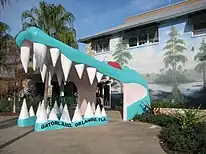
The 🌍 Kennedy Space Center in Cape Canaveral was America's spaceport for the manned missions to the Moon and the Space Shuttle. The Visitor Complex contains spacecraft displays, two IMAX movies, the Astronaut's Hall of Fame, exhibits chronicling the history and future of space exploration, and a Space Shuttle Launch Experience.
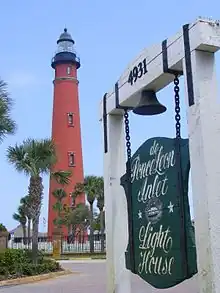
Florida has a long and complex history and is worth visiting for those interested in historical travel. 🌍 St. Augustine, founded by the Spanish in 1565, is the United States' oldest permanent European settlement. It contains a large colonial fort, multiple attractions and site detailing its history, countless restaurants and bars, and plenty of shops in its small, walkable downtown. Florida's Lighthouses are numerous, historic, and beautiful; take some time to visit these iconic images of the coast. 🌍 The Florida Holocaust Museum in downtown Saint Petersburg, this is one of the largest Holocaust museums in the U.S. and exhibits a box car used by Nazis to transport prisoners to extermination camps like Auschwitz. 🌍 Salvador Dalí Museum, also in downtown St. Petersburg, is the largest collection of Dalí artwork outside of Europe.
Sports are popular in the state of Florida, and particularly well-known is 🌍 Daytona International Speedway near FL-92 and I-95 in Daytona Beach. The famous speedway venue is home of the number one event in stock car racing, NASCAR's Daytona 500 (February), along with other events throughout the year. Spring Training baseball occurs throughout the state in late February and March, and offers the ability to watch your favorite players for discount prices (front row tickets can be purchased as low as $15-20) and in smaller, more intimate venues.
🌍 Sunshine Skyway Bridge is the longest cable-stayed bridge in the world and an engineering masterpiece crossing the mouth of Tampa Bay. Two long fishing piers beside the bridge, the approaches of the previous bridge, are renowned among local fishermen and provide a less expensive alternative for saltwater fishing.
🌍 Ybor City (pronounced ee-bor) is one of the largest party districts in the country, with countless bars, restaurants, clubs, and cigar stores, located near downtown Tampa, easily accessible by car or with the free and historic streetcar service. Ybor City has a very historic and authentic feel, with a combination of Latin and Italian influence. Not just a nightlife district, however, with many cultural sights and restaurants open during the day.
Wildlife
- See also: Marine life
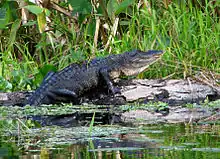
Alligators, crocodiles, manatees, bears, armadillos, dolphins, spoonbills...Florida's diverse array of habitats are home to a variety of wild animals.
Alligators and their relatives can be seen in captivity at the Alligator Farm in Saint Augustine, and the 🌍 Saint John's River, which was expanded to better accommodate riverboats, is also an excellent place to see wildlife. An abundance of marinas and boat tours that exist in the cities north of Orlando have access to this river. It's lined with trees of various species, along with a variety of bird life. To see wild alligators, try Everglades National Park or Myakka River State Park, and you can see manatees at Blue Spring State Park or Weeki Wachee Springs.
🌍 Gatorland in Orlando is full of Florida's most unique animal and is one of the oldest tourist attractions in the state.
Unfortunately, with all the exotic wildlife come a host of insects, especially during the May-October period. These are often encountered outdoors, especially in forested areas, during the summer and are attracted by that season's hot, humid weather, so if you visit between May and early fall, expect to encounter mosquitoes or even "lovebugs". Lovebugs, which are typically seen for just a few weeks during spring and fall, are completely harmless except for the mess they make on moving cars, and are so named because they are seen in pairs. Even more developed areas, if near forests, can attract mosquitoes.
Along with the fauna is flora in its abundance (and variety) due to the warm and wet climate.
Itineraries
- US-1 and Interstate 10 go through the state.
- Lake Ashby Boardwalk crosses a portion of Lake Ashby in Volusia County, Florida, before entering the rainforest.
Do
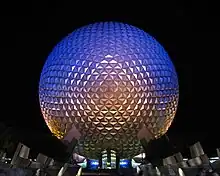
| “ | If you can't find something to do in Florida, you're just boring | ” |
—Guy Fieri, as quoted in the Tampa Bay Times | ||
- Go to the beach! You have numerous options here: Panama City Beach, Daytona Beach, New Smyrna Beach, St. Pete Beach, West Palm Beach and Siesta Key are some of the best.
- Visit Florida's world class theme parks and water parks.
- Walt Disney World - The most visited resort in the world, home to four theme parks, two water parks, and shopping, dining, and hotels galore.
- Universal Orlando - Disney World's biggest competitor, these two theme parks are home to The Wizarding World of Harry Potter.
- SeaWorld in Orlando and Legoland in nearby Winter Haven.
- Busch Gardens in Tampa.
- Visit Everglades National Park, a place like no other on Earth, and take an airboat ride through the swamps. A drive across the Everglades on US 41 is a great way to get a sense of the park's size and scenery. Check out Everglades City for great attractions.
- Explore some of the more than 150 Florida State Parks. The only three-time winner of the National Recreation and Park Association's Gold Medal for state park systems. Get a Florida State Parks Annual Pass for free admission to most of the state parks, or discounted admission at Skyway Fishing Pier State Park, Ellie Schiller Homosassa Springs Wildlife State Park and Weeki Wachee Springs State Park.
- Visit the Seminole or Miccosukee Native American reservations throughout the state. Here you can find out about their history and culture, try their food, and gamble in the casinos on their land, which include several Hard Rock Casinos.
- Go scuba diving or snorkeling through the many coral reefs, sunken vessels, and diverse array of sea life off of Florida's coasts. The most colorful fish can be seen in the tropical waters of Miami and further south.
- Go hiking or backpacking in the many state and national parks and forests that have nature trails suitable for hiking and camping. A particularly good option is the Florida National Scenic Trail, a network of 1400 miles (2253 km) of hiking trails throughout the state. The most popular section of the trail is the 110-mile (177-km) loop encircling Lake Okeechobee.
- Go fishing, with some of the best fishing action in the world (both salt and freshwater). Several large and tough fighting species such as Sailfish, Tarpon, and Largemouth Bass can be found lurking in water throughout the state.
- Take a Cruise from the Port of Miami, Tampa, Fort Lauderdale, or Cape Canaveral on longer cruises run by the likes of Royal Caribbean, Carnival Cruise Line or Disney Cruise Line. There are also short nightly casino cruises in various places.
- View a rocket launch, which are visible from virtually anywhere in the Peninsula when skies are clear. But the best viewing is up-close from Cape Canaveral's Kennedy Space Center, Cocoa Beach, Canaveral National Seashore, or Titusville.
- Check out the Florida State Fair, held every February near Tampa. It hosts an exposition of counties, where each Florida county has a display and a representative to answer questions. In addition, the fair has animal displays and shows, an exhibition dedicated to citrus, various dance & cheerleading competitions, and a large selection of rides and games.
Eat
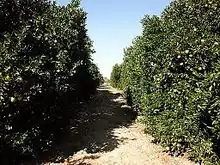
Florida's cuisine is a mix of many influences and its styles vary across the state from North to South. North Florida has a more Southern style; South Florida a more Caribbean one. There specifically, early Spanish and African cuisines have been given a new spin with the impact of Cuban and other Caribbean cultures, as well as from "snowbirds" escaping the Northern U.S. winters. Being on a peninsula, Florida's chefs have always had access to fresh seafood, and the long growing season provides fresh native vegetables almost year round.
- Citrus is a main export, and a tourist is apt to see many roadside stands offering free samples of orange juice and fruits to be shipped or carried home. Florida also grows grapefruit, avocado, mango, papaya, passion fruit, kumquat, coconut and other tropical fruits. These often provide the base for sauces and marinades and are also used in marmalades, soups, and desserts. Official state welcome centers located on I-10, I-75, and I-95 as you enter Florida offer free samples of orange juice to all visitors, a tradition that goes back decades.
- Strawberries are another popular fruit in Florida. Plant City, off I-4 east of Tampa, is the center of the Florida strawberry industry, where during the peak season (Feb-Mar) many roadside vendors offer flats (16 pints/12 lb/5.4 kg) and half-flats of strawberries for a small fraction of grocery store prices. Since most stands are owned by the individual farmers, the fruit sold was often harvested that morning or the day before. Fresh Florida strawberries are a treat no tourist should miss, at least if you visit in-season.
- Grouper is a very popular seafood caught in Florida's coastal waters. Fresh grouper is offered in many coastal cities, where local restaurants buy it straight from fishermen, and it is often served fried or grilled on a sandwich. State inspectors have cracked down to ensure that all restaurants offering "grouper" are in fact serving grouper, and not another less expensive white fish. Snapper, snook, tarpon, marlin, and shark are other Florida fish that you can find at coastal restaurants, although they are not nearly as ubiquitous as grouper.
- Southern food is available throughout most of North and Central Florida. Barbeque is popular throughout the state, with many small "barbeque shacks" to choose from. Any platter costing over $10 ($15 for ribs) should be avoided as the less expensive restaurants are almost always best. Sweet tea is also common throughout the state, although unlike most areas in the South, you have a choice between sweet and unsweet tea. Boiled peanuts, which taste nothing like a regular peanut, can be found at roadside vendors and are certainly worth trying. Dishes such as fried chicken, grits, okra, biscuits & gravy, and collard greens can also be found in restaurants and buffets throughout the state.
- Cuban food is common in the Miami and Tampa areas, with the most common dishes being the Cuban sandwich, flan, and black beans & rice.
- Local specialties, not readily available in many other locales, include alligator. It is healthy and most say it tastes like chicken, and it is often prepared like chicken nuggets. Key lime pie, found elsewhere now, is a Florida Keys invention, made from the local key limes.
Florida bans indoor smoking in restaurants, but it is allowed outdoors unless the establishment prohibits it.
Drink
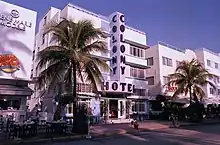
Alcoholic beverages abound throughout the state. However, five rural counties in the northern third of the state are "dry counties", and no alcohol is sold in them. Stand-alone liquor stores are often built into strip malls, supermarkets, and pharmacies, and most grocery stores, gas stations, and convenience stores sell beer and wine. Bars and clubs are popular throughout the state, with Miami Beach being well-known for a variety of themed and upscale bars with innovative mixed drinks. Unique bars and clubs can also be found in downtown Orlando and the nearby tourist areas closer to the theme parks and resorts of Disney and Universal.
No visit to Florida is complete without a cup of their famous orange juice.
Like every other U.S. state, the purchase and possession age for alcohol is 21 and it's fairly well enforced. Underage drinking "stings" are frequent in most tourist areas. Florida allows smoking in bars, including those that serve food, but the bar must get less than 10% of their revenue from food.
Buy
Florida is increasingly becoming a major destination for shopping. The Orlando and Miami areas are home to a plethora of shopping malls, including many outlet malls home to shops selling brand-name products for discounted prices. There are also a large number of stores selling souvenirs, although most are not locally produced. The Kissimmee area near Orlando, especially, has a much larger number of retail stores than is typical of U.S. cities. While traditionally these shops catered largely to American families on vacation, most now serve foreign shoppers who flock to these malls to buy products significantly cheaper than at home. It's not uncommon at some shopping malls in Orlando to encounter tourists from around the globe, especially on weekdays when most Americans are working. In the last few years, Brazil has become the largest source of international visitors to the state, with many coming on shopping group tours and sometimes wearing matching shirts. Due to this, major shopping centers in the Orlando and Miami areas now offer services in Portuguese.
Most goods for sale in the state are subject to sales tax. In most of the state the rate is 7%, but it varies from 6-7.5% (6% state sales tax and up to 1.5% local sales tax). This rate is almost never listed on the advertised or displayed prices.
Respect
If you're using a boat or other vehicle, like a jetski, in the water, it may be necessary to significantly reduce speed in areas inhabited by manatees and/or dolphins. Fast-moving vehicles can cause harm to a manatee's respiratory system.
Misuse of recreation areas has caused record manatee deaths in 2021.
Connect

Internet
Essentially all hotels offer Wi-Fi internet access for guests, and almost always for free; some even have Ethernet ports for higher-speed wired connections. Many businesses also have free Wi-Fi. This even includes some clothing/department, grocery, and convenience stores in addition to the more typical restaurants and shopping malls. All the main airports have free Wi-Fi.
Wi-Fi internet access is also available at public libraries. It's almost always free for everyone with their own device (laptop, smartphone, tablet). Computers set up for internet access by patrons require a username and password to access; nearly all libraries will issue a "guest pass" for non-cardholders, though there is occasionally a nominal fee. Use of library computers is subject to time limits which vary widely.
The large majority of "internet cafes" in the state are actually nominally illegal casinos, set up for online gambling in an attempt to circumvent gambling laws. Such internet cafes do not have typical computers for general use. Instead, they are usually enclosed in a slot machine-style cover with only a few buttons to press, and set up to only view gambling websites. Patrons pay for short periods of time, sometimes using odd methods like buying prepaid phone cards. After a high-profile crackdown on an operator of dozens of such internet cafes, the state banned the opening of all new internet cafes in 2013.
Stay safe
Dialing 911 at any telephone will reach the emergency services (police, fire, ambulance, etc.). Any phone connected to a U.S. network, regardless of whether or not it has a paid account, must be able to dial 911 if it is connected to the network, and such calls are always free.
Crime
Florida has varying crime intensity from city to city. In certain areas of the large cities it may not be safe to walk alone or even in small groups at night, although these are the exceptions and most of Florida is safe for visitors. Tourist areas rarely have violent crimes, but theft is an occasional occurrence. If the area doesn't feel safe, then it probably isn't.
Clip joint operators who trick visitors into paying large amounts of money for low-quality services may use local police to shake down voyagers under a Florida law that requires bar and restaurant patrons pay a disputed bill first and take it up later with their credit card company.
Weather
|
Extreme Temperatures
Never leave children or pets in a parked car for any length of time! Due to the high temperatures most of the year, the interior of a parked car can easily heat to a lethal temperature very quickly. During the summer, the interior of a parked car can reach 130 to 170 °F (54 to 77 °C) in just 15 minutes, regardless of the color of the exterior or interior, nor whether the windows are open a small amount. You not only risk their lives, but it is illegal and the consequences could be thousands in fines and even imprisonment. Vehicles left containing animals or children will be broken into by police or bystanders. |
Florida has a high occurrence of hurricanes, though they don't hit the state every year. You might want to check the hurricane safety page if you are visiting Florida during the Hurricane Season, which runs June 1 to November 30.
Few places in the world experience more frequent lightning strikes than Florida. The summer thunderstorms in Florida produce frequent lightning, which kills people each year and injures many more. Stay indoors during a thunderstorm and never seek shelter under a tree. Most casualties occur on golf courses, but lightning strikes everywhere. If you must go outdoors during a storm, try to stay away from any tall object, especially trees or anything made of metal.
Occasionally, thunderstorms will bring hail, high winds, and tornadoes. While the historical number of tornadoes in Florida is somewhat high, the overwhelming majority have occurred during hurricanes (Hurricane Jeanne alone spawned over 200 tornadoes in Florida). While some do occur during winter cold fronts and summer thunderstorms, 99% of them are weak (F-0/F-1). Thus, while statistics may suggest otherwise, tornadoes are not a big hazard in Florida.
Watch where and when you swim. While the beaches are great they sometimes harbor rip currents, bacteria, and jellyfish. Always check with the lifeguard stand or ranger station before heading in if no one is in the water or if the waves are rough.
Red tide is the name for harmful algal blooms that can occur on Florida's Gulf coast. They cause fish kills and water discoloration, and release toxins into the air that cause respiratory irritation. People with severe or chronic respiratory conditions, such as emphysema or asthma, should avoid areas where red tide is occurring. Swimming in water afflicted by red tide can cause skin and eye irritation and is not recommended.
Heavy rain can make the roads dangerous. Although many highway drainage systems in Florida are well-designed by necessity, it can be almost impossible to see through your windshield during the worst rainstorms. Light and torrential rain can be a hundred feet apart, so when you hit heavy rain, it's common for vehicular traffic to slow to speeds as low as 20 mph if necessary, even on major interstates. However, there are a few drivers who ignore the protocol and drive fast anyway. Even though it's common, it's illegal to drive with hazard lights on in the rain. Use them only if you are completely stopped.
Wildlife
- Main article: Dangerous animals
Alligators are a threat throughout Florida (even in inland areas like Orlando and the Walt Disney World), and it should be assumed that they are present in all stagnant or slow moving freshwater. Never swim in any lakes or rivers unless signs tell you swimming is safe, and beware when approaching the water anywhere. Do not allow children or pets to approach the water's edge.
Bears and Florida panthers, common before the arrival of Europeans in Florida, are now both endangered in the state. If you do see either, back off slowly or keep your distance, and make yourself appear larger by waving your arms above your head. When hiking, make lots of noise to avoid startling an animal, and always keep small children close to you. Both species are endangered and protected under Florida law, and harassing or injuring one (even in a vehicle accident) will result in prosecution.
Volusia County is known for a high number of shark attacks, but they can occur anywhere in the state, so be careful when surfing. Even so, the number of attacks are less than 50, with a fatal attack every 2-3 years, amongst millions of visitors and residents who swim in the ocean. Swimming near dusk and dawn is the most hazardous.
Lionfish are a poisonous and invasive fish that are now present on reefs throughout Florida. They can be identified by their red-and white striped bodies and poisonous spines. Stings are extremely painful and often require hospitalization. Due to their status as an invasive species, any sighting of lionfish should be reported to wildlife management authorities immediately.
Jellyfish are also sometimes common at the beaches, and venomous snakes can be found year round across the state, so it is good to be wary of both.
Cope
Consulates
A large number of countries have consulates in and around Miami, with a much smaller number in Jacksonville, Orlando and Tampa. Full listings for these consulates and honorary consulates are in the articles for the cities where they are located. Always call ahead to determine if the consulate offers the services you require, such as passports, visas, and other official documents, as these services are increasingly being centralized at other locations. Some websites are available only in Spanish.
Go next
- Georgia - Heading out of Florida to the north is Georgia, with the historic city of Savannah and the resort beaches of Jekyll Island close by.
- Alabama - North of the Panhandle is Alabama, with the historic port of Mobile and popular resort town Gulf Shores a short drive away from this region of Florida.
- Caribbean - The islands of the Caribbean are accessible by boat and plane from across Florida and offer a variety of both relaxing and adventure travel amidst a tropical paradise. For those interested in visiting the Bahamas, many owners of small boats will make the day-long trip to the island chain, and several small airlines offer flights for under $70 each way.